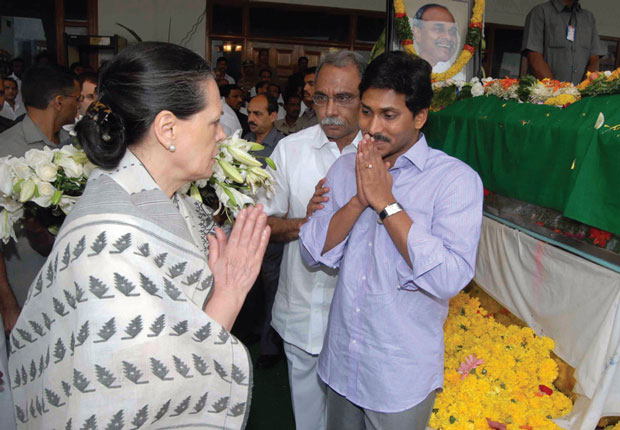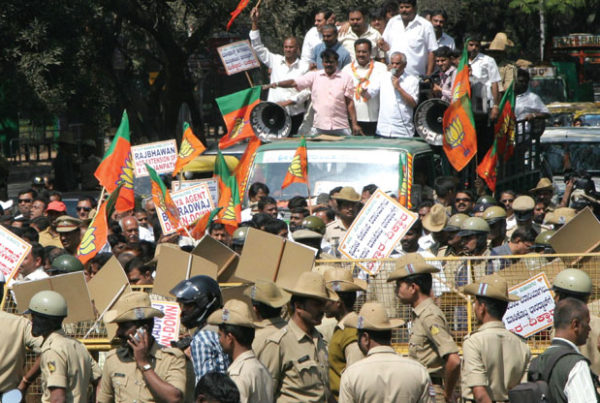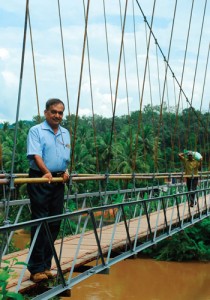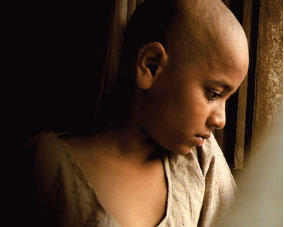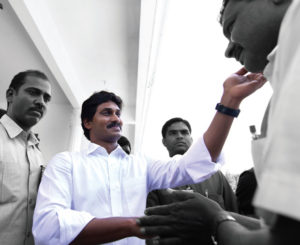 Godson? Awaiting the political call, Jagan has seamlessly assumed YSR’s public persona
Godson? Awaiting the political call, Jagan has seamlessly assumed YSR’s public personaPhoto: Shailedra Pandey
THE FRENCH called it the law of le mort saisit le vif— sovereignty was instantaneously transferred the moment the previous monarch died. In England, the traditional pronouncement ran, “The King is dead! Long live the King!” In democratic India, circa 2009, if 152 members of the Andhra Pradesh Congress party had had their way, the chief ministership of the state would have passed in similar fashion – instantaneously — from dead father to novice son.
The sudden disappearance of Chief Minister YSR Reddy’s helicopter on September 2, 2009 was undoubtedly a big shock; the discovery of his mangled helicopter a day later, tragic. YSR was only 60 and riding a power wave with his second term as chief minister. He had just delivered 33 MPs in the Lok Sabha election and seemed unstoppable. Everywhere in the world, untimely deaths have a way of creating rosy afterglows. In India, it can engender saintly halos – lunar-size. As news of YSR’s death was confirmed, hagiographies began to flood newspapers and channels: YSR the “people’s king”, the “popular CM”, the master of the padyatra. Weeping faces lined the driveway to his home. Then suddenly, through the crescendo of ritual mourning, a breakaway note was heard: Make Jagan CM, make Jagan CM. Within hours, it had become a raucous symphony.
Not too many people outside the state had heard of YSR’s son, Jaganmohan Reddy, and if you watched the 36-year-old stoically receiving mourners, cupping everyone’s chin, young and old, in a commiserative gesture, you’d imagine he had absolutely no hand in this spontaneous outcry. But the key to the Reddys — both father and son — do not lie in the careful constructs of their public life. Previously, YSR was a four-time MP from the Kadapa constituency in Rayalaseema; he shifted to Pulivendula constituency later. In May this year, Jagan stood and won his first Lok Sabha election from Kadapa.
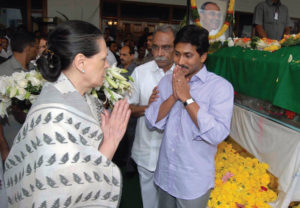 In limbo Cryptic silence from the Congress has delayed the transfer of power
In limbo Cryptic silence from the Congress has delayed the transfer of powerPhoto: AFP
Now, as the roar to install him as CM gained ground, the Congress High Command moved swiftly. Senior leaders like Digvijay Singh, Pranab Mukherjee and Veerappa Moily were sent down to the state. KVP Ramachandra Rao, YSR’s most trusted aide, an old medical college friend and current orchestra-conductor of the Jagan-as-CM campaign, was summoned to Delhi and told to button up. Jagan too was instructed to put out a formal plea on September 6 to wind down the song. Still, almost all the party MLAs in the state boycotted the first meeting called by the interim chief minister K Rosiah; and there were reports of an imminent split.
SO WHAT rattled the Congress at the Centre? As first-time MP — that too only a hundred days old in Parliament — Jagan is hardly fit material for chief ministership. Besides, it would make for poor optics to pass the baton from father to son. But was that the only reason? And how was one to read his inexplicable popularity? Why were 152 MLAs clamouring for him? Was it merely good old Indian sentimentality, or was there more?
Rayalaseema, the Reddy’s home country, seems to hold many answers. Rayalaseema is the legendary badlands of Andhra Pradesh – notorious for its endemic culture of violence, murder and unbridled factionalism. Bomb explosions, country-made, are routine there. (The saying goes, in Rayalseema, even an angry glance can attract a bomb attack). Lethal guns are the new entrants. A report in Frontline in 2005 said an astounding 670 Congressmen and 560 TDP men had lost their lives to factional rivalries in just the previous 15 years. Even the police admit that the “only ideology” in these testosterone, faction-ridden villages is violence. (A lorry driver, for instance, was shot point-blank for not allowing a faction leader to overtake his vehicle.) The roots of this psychology apparently trace back hundreds of years to the Vijayanagara empire in the 14th century, when its rulers began to depend on powerful village chieftains called ‘poligars’ for military support in crisis. In return, the poligars were pumped with money and given autonomy. This bred local rivalries and vicious competitive domains that have persisted into the 21st century. (The British apparently tried to break this rampant factionism by hanging a couple of poligars publicly, but achieved nothing.)
IN THE LEGENDARY BADLANDS OF RAYALASEEMA, EVEN AN ANGRY GLANCE CAN ATTRACT A BOMB ATTACK. JAGAN IS SPROUTED OF THIS STOCK
YSR was one of the most powerful faction heads in Rayalaseema. His father Raja Reddy, an affluent local contractor, thriving on the largesse of government contracts, was killed in a bomb attack in his native Kadapa district while driving home on May 23, 1998. According to news reports at the time, one of the accused, Perla Uma Maheswara Reddy, who sustained splinter injuries while attacking Raja Reddy, was hacked to death in retaliation on the same day. Four of the other accused died during the trial.
Jagan Reddy is sprouted of this stock. In 2005, he was accused of orchestrating the murder of controversial TDP leader Paritala Ravindra. The police filed an FIR against him, but a CBI enquiry exonerated him. Still, many lesser stories abound of him unleashing his fury on police constables or inspectors who dared stand up to him. In one such incident, a police inspector caught several men hunting rabbits without license in Simhadripuram town. They turned out to be Jagan’s acolytes. When he landed up at the police station to rescue his friends, there was such a violent melee, the inspector locked himself inside the cell, refusing to come out.
K Balagopal, an advocate and member of Human Rights Forum, who spoke to the policemen at the station after the incident, says, “As comical as it may sound, this story is characteristic of the culture prevalent in Kadapa. Faction leaders here often kill to protect their gang and its interests.” In 2004, when YSR was elected CM, Balagopal wrote a scathing and exhaustive article, ‘Beyond Media Images’ in the Economic and Political Weekly detailing the violence that had underlined his rise to power. The chief minister was forced to respond to it when Indian Express editor Shekhar Gupta challenged him on it in a televised interview. Coolly, YSR dismissed it as entirely untrue.
In off-the-record conversations, none of the family’s close associates deny the legacy of violence that has marked the family. “It’s all about perspective,” says one intimate party senior. Another senior colleague from Jagan’s media corporation attributes the violence to “a fight waged by Jagan and his family for the downtrodden.” He continues, “They have always been on the side of those who support them. They go to any length to protect the interests of those who are with them. Jagan understands these concepts very well.”
HOURS AFTER YSR’S DEATH, JAGAN’S SAKSHI CHANNEL RAN A TICKER SAYING PEOPLE WERE COMMITTING SUICIDE. OTHER MEDIA PICKED UP THE RUMOUR
Opinion on Jagan within the party is obviously very divided. A senior Congressman in Delhi says dismissively, “Jagan is just a sleazeball, the spoilt son of a rich father, a money manager. He does not enjoy any spontaneous popularity in the state. It’s just that these Reddys are a wild and vengeful lot. Many of the MLAs signed up thinking, god forbid, if he makes it to the post, we better have been supporting him.” Another senior party leader and Rajya Sabha member alleged that many of the signatures endorsing Jagan as chief minister were obtained under threat.
CLEARLY, JAGAN and his supporters are not above a bit of stage-management. Within hours of YSR’s death, Sakshi channel, owned by Jagan, began to run a ticker saying grief-stricken people in the state were committing suicide. Other media organisations snowballed the rumour. Post that, the Congress Legislature Party began to put out periodic bulletins about the rising deaths. On last count, 462 people had died of heartbreak: 402 heart attacks, 60 suicides. However, on September 16, in a damaging report, Mail Today published a story detailing how many of these deaths had actually been of unrelated and natural causes. The reporter spoke to the relatives of many of the deceased: they said they had been paid an average of Rs 5,000 to pretend their kin had killed themselves over YSR.
Like Rayalaseema, Sakshi channel too offers many clues about Jagan. A capacity for violence is only one of the attributes people ascribe to him – the other is meteoric wealth. In June 2008, two months after he had launched his Telugu newspaper, Sakshi,Jagan gave a proud interview to an online publication. “It feels great that Sakshi is currently the largest circulated Telugu daily with a 13 lakh circulation. What Eenadu achieved in 30 years we have accomplished in 60 days,” he said. According to this interview, he also said Deloitte had valued Sakshi at Rs 3,500 crores. But Sakshi newspaper is only part of it. Media professionals also marvel at the money Jagan poured into his television channel. Some quick ballparks tell their own story: an average national channel has 10-12 DSNGs (smaller versions of OB vans) because it is an expensive proposition. Jagan got one each for all 23 districts of Andhra Pradesh and for the four metro bureaus.
Jagati Publications, which owns Sakshi newspaper and television, is only Jagan’s most visible venture. He also has interests in power generation plants, uranium and bauxite mining corporations, cement plants and SEZs. There are also real estate investments and mining interests in Karnataka, where he is closely associated with the famous ‘Reddy brothers’ of the mining lobby. Both political and business rivals like TDP honcho Chandrababu Naidu and V Radhakrishna, managing director of Andhra Jyothy, a Telugu daily, routinely accuse Jagan of corruption and benefiting from his father’s regime. “I won’t call Jagan a shrewd businessman,” says Radhakrishna. “Would he have succeeded without high levels of political influence?”
Confronted with such questions, a family member and Jagan’s colleague in the media corporations smiles magnanimously. “YSR always believed in one thing – that for a leader to be strong, his henchmen had to be strong. Unless YSR was strong politically and economically, how could he take care of everyone? Jagan is only following that legacy.”
He might have gone through the public charade of asking people to stop clamouring to make him CM. But in private, unperturbed, Jagan continues to assert his right to the post. Meeting TEHELKA briefly at the chief minister’s camp office in Begumpet, Hyderabad, he talks candidly of how he is best placed to carry forward the dreams of his father. With YSR’s towering portraits behind him, he says: “I have observed him at close hand for many years now. I was there at the meetings when people thronged the house, when he went to the villages. I know more than anyone else how he conducted his affairs.” Why the delay from the Centre then in making the announcement? “My mind will go wild if I begin to speculate,” says he.
He won’t have to speculate long. There are proprieties that stop Indian democracy from being a medieval French monarchy. Yet money, power and a capacity for creating trouble have their own influence. Senior Congress leaders in Delhi say that Jagan might be made head of the state PCC, or a minister in the Cabinet, or even Deputy CM of Andhra Pradesh. That’s not bad for someone who is legitimately only a 100 days old in politics. With his long past and training under his father, that’s only a step away from CM.
—
This article was originally published in Tehelka, a leading independent news magazine in India, known for its investigative journalism.
